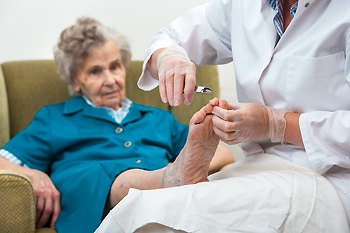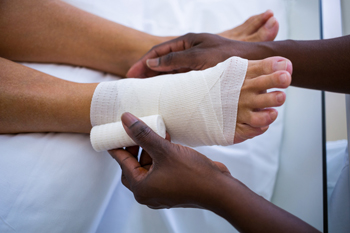
As we age, our feet undergo various changes, often leading to discomfort and mobility issues. Treatment for common foot ailments among seniors varies, depending on the condition. Bunions may require shoe modifications, custom orthotics, medication, or surgery from a podiatrist. Hammertoe deformities may necessitate changes in footwear or in some cases surgery. Toenail problems, including ingrown nails and infections, require professional attention to prevent complications, with podiatrists offering specialized care and treatment options. Seniors with diabetes must prioritize foot health and regular podiatric evaluations to prevent serious complications, such as foot ulcers or gangrene. Plantar fasciitis treatment ranges from conservative measures, such as exercises, to surgery for effective relief. Arch problems, whether flat feet or high arches, generally necessitate a non-surgical approach along with expert guidance to manage discomfort and prevent further complications. For help with any of the many foot conditions common among seniors, it is suggested that you schedule an appointment with a podiatrist for a thorough foot exam, diagnosis, and treatment options.
Proper foot care is something many older adults forget to consider. If you have any concerns about your feet and ankles, contact Dr. John P. Beaupied from Palos Podiatry. Our doctor can provide the care you need to keep you pain-free and on your feet.
The Elderly and Their Feet
As we age we start to notice many changes in our body, but the elder population may not notice them right away. Medical conditions may prevent the elderly to take notice of their foot health right away. Poor vision is a lead contributor to not taking action for the elderly.
Common Conditions
- Neuropathy – can reduce feeling in the feet and can hide many life-threatening medical conditions.
- Reduced flexibility – prevents the ability of proper toenail trimming, and foot cleaning. If left untreated, it may lead to further medical issues.
- Foot sores – amongst the older population can be serious before they are discovered. Some of the problematic conditions they may face are:
- Gouging toenails affecting nearby toe
- Shoes that don’t fit properly
- Pressure sores
- Loss of circulation in legs & feet
- Edema & swelling of feet and ankles
Susceptible Infections
Diabetes and poor circulation can cause general loss of sensitivity over the years, turning a simple cut into a serious issue.
If you have any questions please feel free to contact our office located in Palos Heights, IL . We offer the newest diagnostic and treatment technologies for all your foot and ankle needs.

Athlete's foot, medically termed tinea pedis, is a fungal infection that appears in various forms, each with distinct characteristics and associated risks. Among these, interdigital infection stands out as the most prevalent, affecting the skin between the toes and causing redness, scaling, and persistent itching. Moccasin infection is found on the sole of the foot, often masquerading as eczema due to its dry, cracked appearance. Vesicular infection results in blisters filled with pus that can rupture into open sores, heightening the risk of secondary bacterial infections. Meanwhile, ulcerative infection presents the most discomfort, with painful, oozing sores between the toes, significantly increasing susceptibility to further complications. These variations stem from exposure to dermatophytes, which are fungi thriving in warm, moist environments. Athlete’s foot infections commonly spread in communal spaces such as locker rooms, swimming pools, and shared footwear. Risk factors for contracting athlete's foot include compromised immune function, genetic predisposition, and prolonged periods of wearing tight, non-breathable shoes. If you have a problematic case of athlete’s foot, it is suggested that you schedule an appointment with a podiatrist for advanced treatment options.
Athlete’s foot is an inconvenient condition that can be easily reduced with the proper treatment. If you have any concerns about your feet and ankles, contact Dr. John P. Beaupied from Palos Podiatry. Our doctor will treat your foot and ankle needs.
Athlete’s Foot: The Sole Story
Athlete's foot, also known as tinea pedis, can be an extremely contagious foot infection. It is commonly contracted in public changing areas and bathrooms, dormitory style living quarters, around locker rooms and public swimming pools, or anywhere your feet often come into contact with other people.
Solutions to Combat Athlete’s Foot
- Hydrate your feet by using lotion
- Exfoliate
- Buff off nails
- Use of anti-fungal products
- Examine your feet and visit your doctor if any suspicious blisters or cuts develop
Athlete’s foot can cause many irritating symptoms such as dry and flaking skin, itching, and redness. Some more severe symptoms can include bleeding and cracked skin, intense itching and burning, and even pain when walking. In the worst cases, Athlete’s foot can cause blistering as well. Speak to your podiatrist for a better understanding of the different causes of Athlete’s foot, as well as help in determining which treatment options are best for you.
If you have any questions please feel free to contact our office located in Palos Heights, IL . We offer the newest diagnostic and treatment technologies for all your foot and ankle needs.

Treating diabetic foot wounds requires a comprehensive approach focused on promoting healing and preventing further complications. It begins with identifying and addressing the factors that can contribute to the wound, such as wearing proper footwear and avoiding further injury. Keeping the wound clean and protected with specialized dressings is essential to create an optimal environment for healing. Regular removal of dead tissue and calluses helps prevent infections and allows new tissue to grow. Managing bacteria surrounding the wound site is especially vital, along with ensuring good blood flow to the wound. This may involve medications or procedures to improve circulation. Off-loading techniques, like using cushions or specialized shoes, help reduce pressure on the foot wound, allowing it to heal more effectively. A podiatrist can offer personalized care and guidance throughout the diabetic wound treatment process. If you have developed a diabetic foot wound, it is suggested that you schedule an appointment with a podiatrist for correct management tips.
Wound care is an important part in dealing with diabetes. If you have diabetes and a foot wound or would like more information about wound care for diabetics, consult with Dr. John P. Beaupied from Palos Podiatry. Our doctor will assess your condition and provide you with quality foot and ankle treatment.
What Is Wound Care?
Wound care is the practice of taking proper care of a wound. This can range from the smallest to the largest of wounds. While everyone can benefit from proper wound care, it is much more important for diabetics. Diabetics often suffer from poor blood circulation which causes wounds to heal much slower than they would in a non-diabetic.
What Is the Importance of Wound Care?
While it may not seem apparent with small ulcers on the foot, for diabetics, any size ulcer can become infected. Diabetics often also suffer from neuropathy, or nerve loss. This means they might not even feel when they have an ulcer on their foot. If the wound becomes severely infected, amputation may be necessary. Therefore, it is of the upmost importance to properly care for any and all foot wounds.
How to Care for Wounds
The best way to care for foot wounds is to prevent them. For diabetics, this means daily inspections of the feet for any signs of abnormalities or ulcers. It is also recommended to see a podiatrist several times a year for a foot inspection. If you do have an ulcer, run the wound under water to clear dirt from the wound; then apply antibiotic ointment to the wound and cover with a bandage. Bandages should be changed daily and keeping pressure off the wound is smart. It is advised to see a podiatrist, who can keep an eye on it.
If you have any questions, please feel free to contact our office located in Palos Heights, IL . We offer the newest diagnostic and treatment technologies for all your foot care needs.




